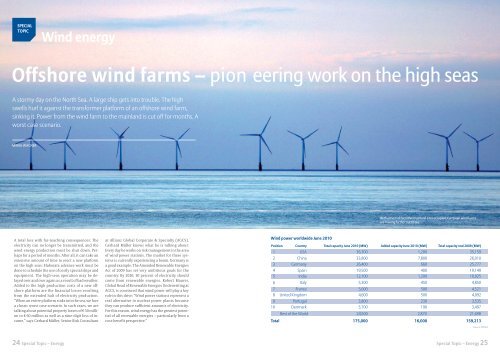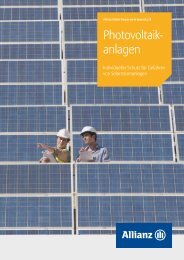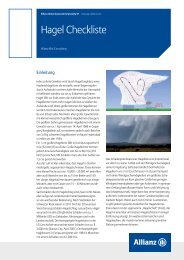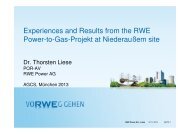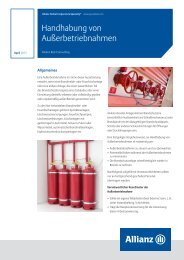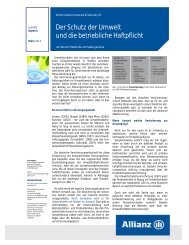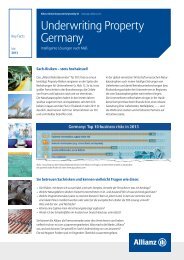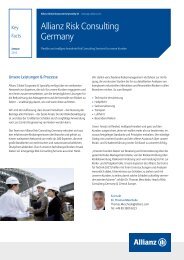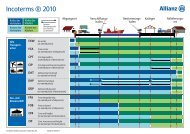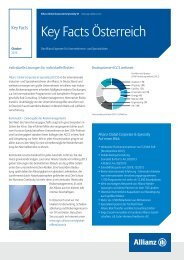Energy - Allianz Global Corporate & Specialty
Energy - Allianz Global Corporate & Specialty
Energy - Allianz Global Corporate & Specialty
Create successful ePaper yourself
Turn your PDF publications into a flip-book with our unique Google optimized e-Paper software.
SPECIAL<br />
TOPIC<br />
Wind energy<br />
Offshore wind farms – pion eering work on the high seas<br />
A stormy day on the North Sea. A large ship gets into trouble. The high<br />
swells hurl it against the transformer platform of an offshore wind farm,<br />
sinking it. Power from the wind farm to the mainland is cut off for months. A<br />
worst case scenario.<br />
MARIA WAGNER<br />
A total loss with far-reaching consequences: The<br />
electricity can no longer be transmitted, and the<br />
wind energy production must be shut down. Perhaps<br />
for a period of months. After all, it can take an<br />
extensive amount of time to erect a new platform<br />
on the high seas: Elaborate advance work must be<br />
done to schedule the use of costly special ships and<br />
equipment. The high-seas operation may be delayed<br />
over and over again as a result of bad weather.<br />
Added to the high production costs of a new offshore<br />
platform are the financial losses resulting<br />
from the extended halt of electricity production.<br />
“When an entire platform sinks into the sea, we face<br />
a classic worst case scenario. In such cases, we are<br />
talking about potential property losses of € 50 million<br />
to € 60 million as well as a nine-digit loss of income,”<br />
says Gerhard Müller, Senior Risk Consultant<br />
24 Special Topic – <strong>Energy</strong><br />
at <strong>Allianz</strong> <strong>Global</strong> <strong>Corporate</strong> & <strong>Specialty</strong> (AGCS).<br />
Gerhard Müller knows what he is talking about:<br />
Every day he works on risk management in the area<br />
of wind power stations. The market for these systems<br />
is currently experi encing a boom. Germany is<br />
a good example. The Amended Renewable Energies<br />
Act of 2009 has set very ambitious goals for the<br />
country: By 2020, 30 percent of electricity should<br />
come from renewable energies. Robert Maurer,<br />
<strong>Global</strong> Head of Renew able Energies Underwriting at<br />
AGCS, is convinced that wind power will play a key<br />
role in this drive: “Wind power stations represent a<br />
real alternative to nuclear power plants because<br />
they can produce sufficient amounts of electricity.<br />
For this reason, wind energy has the greatest potential<br />
of all re newable energies – particularly from a<br />
cost-benefit perspective.”<br />
Wind power worldwide June 2010<br />
With almost all lucrative mainland sites occupied, European wind farms<br />
are moving farther out to sea.<br />
Position Country Total capacity June 2010 (MW) Added capacity June 2010 (MW) Total capacity end 2009 (MW)<br />
1 USA 36,300 1,200 35,159<br />
2 China 33,800 7,800 26,010<br />
3 Germany 26,400 660 25,777<br />
4 Spain 19,500 400 19,149<br />
5 India 12,100 1,200 10,925<br />
6 Italy 5,300 450 4,850<br />
7 France 5,000 500 4,521<br />
8 United Kingdom 4,600 500 4,092<br />
9 Portugal 3,800 230 3,535<br />
10 Denmark 3,700 190 3,497<br />
Rest of the World 24,500 2,870 21,698<br />
Total 175,000 16,000 159,213<br />
Source: WWEA<br />
Special Topic – <strong>Energy</strong> 25


